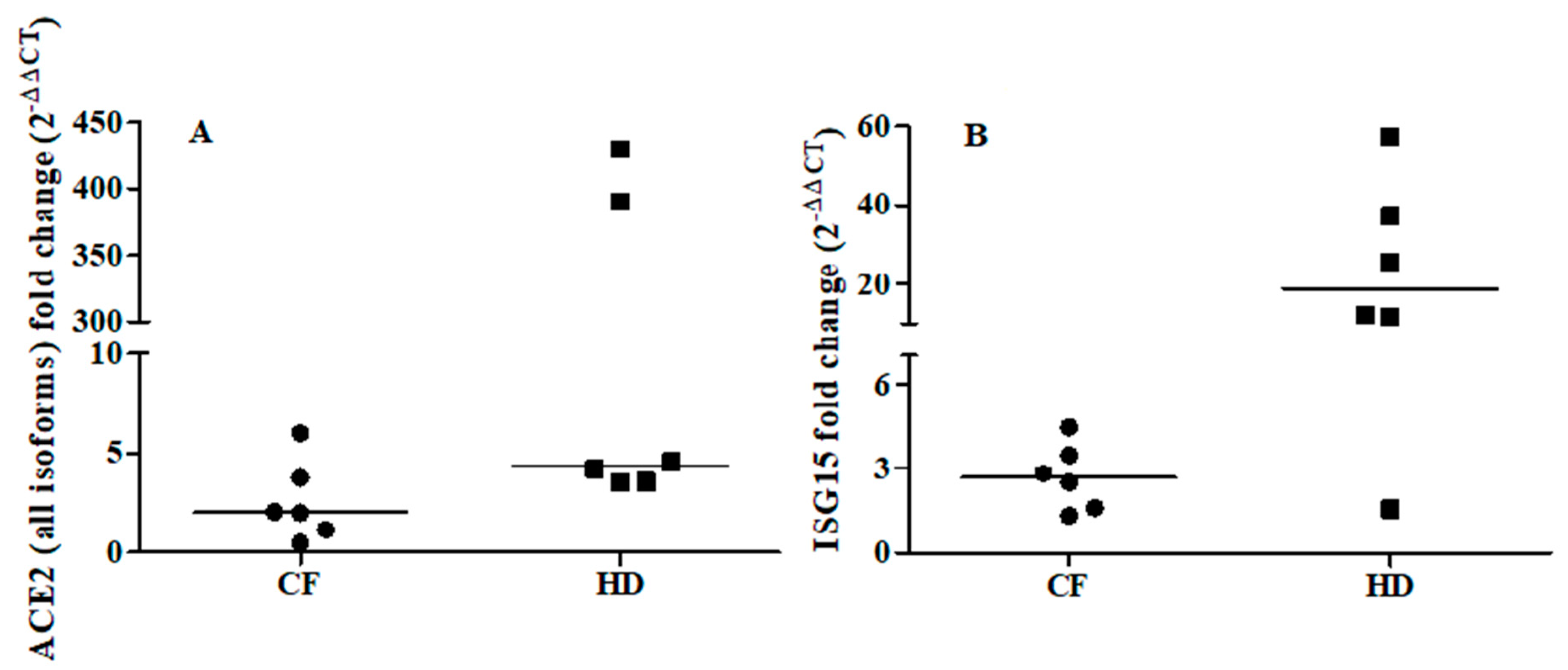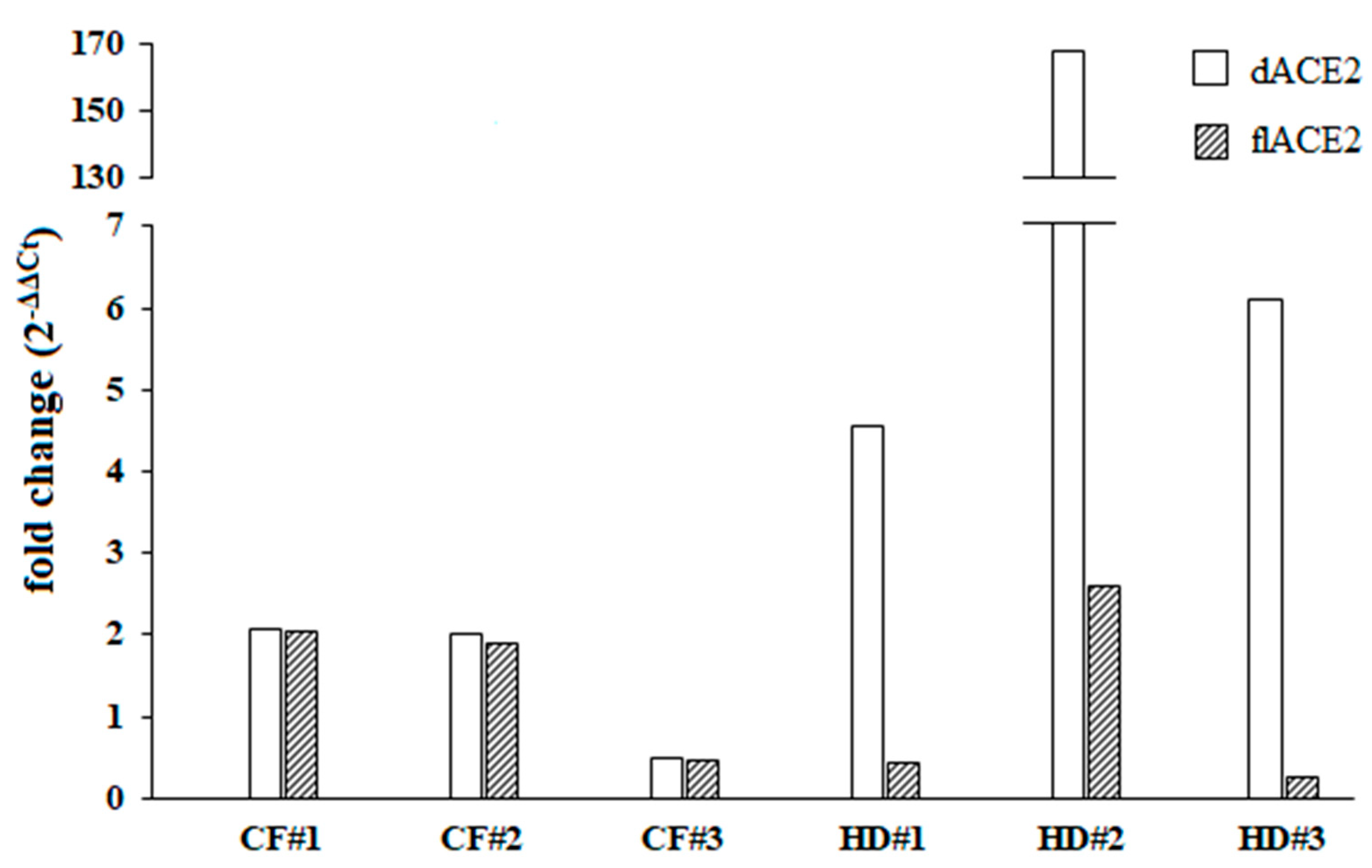SARS-CoV-2 Entry Genes Expression in Relation with Interferon Response in Cystic Fibrosis Patients
Abstract
:1. Introduction
2. Materials and Methods
2.1. Patients and Study Design
2.2. Gene Expression Analysis
2.3. Ex Vivo IFN Induction Experiments
2.4. Statistical Analysis
3. Results
4. Discussion
Author Contributions
Funding
Institutional Review Board Statement
Informed Consent Statement
Conflicts of Interest
References
- Colombo, C.; Burgel, P.R.; Gartner, S.; van Koningsbruggen-Rietschel, S.; Naehrlich, L.; Sermet-Gaudelus, I.; Southern, K.W. Impact of COVID-19 on people with cystic fibrosis. Lancet. Respir. Med. 2020, 8, E35–E36. [Google Scholar]
- Cosgriff, R.; Ahern, S.; Bell, S.C.; Brownlee, K.; Burgel, P.-R.; Byrnes, C.; Corvol, H.; Cheng, S.Y.; Elbert, A.; Faro, A.; et al. A multinational report to characterise SARS-CoV-2 infection in people with cystic fibrosis. J. Cyst. Fibros. 2020, 19, 355–358. [Google Scholar] [CrossRef] [PubMed]
- Ecfs.eu. 2020. COVID-CF Project In Europe | European Cystic Fibrosis Society (ECFS. Available online: https://www.ecfs.eu/covid-cf-projecteurope (accessed on 12 October 2020).
- Scagnolari, C.; Bitossi, C.; Frasca, F.; Viscido, A.; Oliveto, G.; Scordio, M.; De Vito, C.; Trancassini, M.; Midulla, F.; Cimino, G.; et al. No detection of SARS-CoV-2 in cystic fibrosis patients at the Regional (Lazio) Reference Center for CF in Italy. J. Cyst. Fibros. 2020, 19, 837–838. [Google Scholar] [CrossRef] [PubMed]
- Matsuyama, S.; Nagata, N.; Shirato, K.; Kawase, M.; Takeda, M.; Taguchi, F. Efficient activation of the severe acute respiratory syndrome coronavirus spike protein by the transmembrane protease TMPRSS2. J. Virol. 2010, 84, 12658–12664. [Google Scholar] [CrossRef] [PubMed] [Green Version]
- Shang, J.; Wan, Y.; Luo, C.; Ye, G.; Geng, Q.; Auerbach, A.; Li, F. Cell entry mechanisms of SARS-CoV-2. Proc. Natl. Acad. Sci. USA 2020, 117, 11727–11734. [Google Scholar] [CrossRef] [PubMed]
- Seyran, M.; Takayama, K.; Uversky, V.N.; Lundstrom, K.; Palù, G.; Sherchan, S.P.; Attrish, D.; Rezaei, N.; Aljabali, A.A.A.; Ghosh, S.; et al. The structural basis of accelerated host cell entry by SARS-CoV-2†. FEBS J. 2020. (online ahead of print). [Google Scholar] [CrossRef]
- Nie, Y.; Wang, P.; Shi, X.; Wang, G.; Chen, J.; Zheng, A.; Wang, W.; Wang, Z.; Qu, X.; Luo, M.; et al. Highly infectious SARS-CoV pseudotyped virus reveals the cell tropism and its correlation with receptor expression. Biochem. Biophys. Res. Commun. 2004, 321, 994–1000. [Google Scholar] [CrossRef]
- Ziegler, C.G.K.; Allon, S.J.; Nyquist, S.K.; Mbano, I.M.; Miao, V.N.; Tzouanas, C.N.; Cao, Y.; Yousif, A.S.; Bals, J.; Hauser, B.M.; et al. SARS-CoV-2 Receptor ACE2 Is an Interferon-Stimulated Gene in Human Airway Epithelial Cells and Is Detected in Specific Cell Subsets across Tissues. Cell 2020, 181, 1016–1035e19. [Google Scholar] [CrossRef]
- Smith, J.C.; Sausville, E.L.; Girish, V.; Yuan, M.L.; Vasudevan, A.; John, K.M.; Sheltzer, J.M. Cigarette Smoke Exposure and Inflammatory Signaling Increase the Expression of the SARS-CoV-2 Receptor ACE2 in the Respiratory Tract. Dev. Cell 2020, 53, 514–529e3. [Google Scholar] [CrossRef]
- Hou, Y.J.; Okuda, K.; Edwards, C.E.; Martinez, D.R.; Asakura, T.; Dinnon III, K.H.; Kato, T.; Lee, R.E.; Yount, B.L.; Mascenik, T.M. SARS-CoV-2 Reverse Genetics Reveals a Variable Infection Gradient in the Respiratory Tract. Cell 2020, 182, 429–446e14. [Google Scholar] [CrossRef]
- Onabajo, O.O.; Banday, A.R.; Stanifer, M.L.; Yan, W.; Obajemu, A.; Santer, D.M.; Florez-Vargas, O.; Piontkivska, H.; Vargas, J.M.; Ring, T.J.; et al. Interferons and viruses induce a novel truncated ACE2 isoform and not the full-length SARS-CoV-2 receptor. Nat. Genet. 2020, 52, 1283–1293. [Google Scholar] [CrossRef] [PubMed]
- Busnadiego, I.; Fernbach, S.; Pohl, M.O.; Karakus, U.; Huber, M.; Trkola, A.; Stertz, S.; Hale, B.G. Antiviral Activity of Type I, II, and III Interferons Counterbalances ACE2 Inducibility and Restricts SARS-CoV-2. mBio 2020, 11, e01928-20. [Google Scholar] [CrossRef] [PubMed]
- Ansari, M.A.; Marchi, E.; Ramamurthy, N.; Aschenbrenner, D.; Hackstein, C.-P.; Lin, S.-K.; Bowden, R.; Sharma, E.; STOP-HCV consortium, ISARIC-4C Investigators. Negative regulation of ACE2 by interferons in vivo and its genetic control. medRxiv 2008. Preprint. [Google Scholar]
- Kormann, M.S.D.; Dewerth, A.; Eichner, F.; Baskaran, P.; Hector, A.; Regamey, N.; Hartl, D.; Handgretinger, R.; Antony, J.S. Transcriptomic profile of cystic fibrosis patients identifies type I interferon response and ribosomal stalk proteins as potential modifiers of disease severity. PLoS ONE 2017, 12, e0183526. [Google Scholar] [CrossRef] [Green Version]
- Corman, V.M.; Landt, O.; Kaiser, M.; Molenkamp, R.; Meijer, A.; Chu, D.K.W.; Bleicker, T.; Brünink, S.; Schneider, J.; Schmidt, M.L.; et al. Detection of 2019 novel coronavirus (2019-nCoV) by real-time RT-PCR. Euro. Surveill. 2020, 25, 2000045. [Google Scholar] [CrossRef] [Green Version]
- Pierangeli, A.; Viscido, A.; Bitossi, C.; Frasca, F.; Gentile, M.; Oliveto, G.; Frassanito, A.; Nenna, R.; Midulla, F.; Scagnolari, C. Differential interferon gene expression in bronchiolitis caused by respiratory syncytial virus-A genotype ON1. Med. Microbiol. Immunol. 2020, 209, 23–28. [Google Scholar] [CrossRef]
- Donaldson, S.H.; Hirsh, A.; Li, D.C.; Holloway, G.; Chao, J.; Boucher, R.C.; Gabriel, S.E. Regulation of the epithelial sodium channel by serine proteases in human airways. J. Biol. Chem. 2002, 277, 8338–8345. [Google Scholar] [CrossRef] [Green Version]
- Anand, P.; Puranik, A.; Aravamudan, M.; Venkatakrishnan, A.J.; Soundararajan, V. SARS-CoV-2 strategically mimics proteolytic activation of human ENaC. Elife 2020, 9, e58603. [Google Scholar] [CrossRef]
- Parra-Lara, L.G.; Martínez-Arboleda, J.J.; Rosso, F. Azithromycin and SARS-CoV-2 infection: Where we are now and where we are going. J. Glob. Antimicrob. Resist. 2020, 22, 680–684. [Google Scholar] [CrossRef]
- Cole-Jeffrey, C.T.; Liu, M.; Katovich, M.J.; Raizada, M.K.; Shenoy, V. ACE2 and Microbiota: Emerging Targets for Cardiopulmonary Disease Therapy. J. Cardiovasc. Pharmacol. 2015, 66, 540–550. [Google Scholar] [CrossRef] [Green Version]
- Imai, Y.; Kuba, K.; Rao, S.; Huan, Y.; Guo, F.; Guan, B.; Yang, P.; Sarao, R.; Wada, T.; Leong-Poi, H.; et al. Angiotensin-converting enzyme 2 protects from severe acute lung failure. Nature 2005, 436, 112–116. [Google Scholar] [CrossRef] [PubMed]
- Batlle, D.; Jose Soler, M.; Ye, M. ACE2 and diabetes: ACE of ACEs? Diabetes 2010, 59, 2994–2996. [Google Scholar] [CrossRef] [PubMed] [Green Version]
- Clementi, N.; Ferrarese, R.; Criscuolo, E.; Diotti, R.A.; Castelli, M.; Scagnolari, C.; Burioni, R.; Antonelli, G.; Clementi, M.; Mancini, N. Interferon-β 1a inhibits SARS-CoV-2 in vitro when administered after virus infection. J. Infect. Dis. 2020, jiaa350, [ahead of print]. [Google Scholar] [CrossRef]
- Schoggins, J.W. Interferon-Stimulated Genes: What Do They All Do? Annu. Rev. Virol. 2019, 6, 567–584. [Google Scholar] [CrossRef]


| Items | Cystic Fibrosis n = 46 | Healthy Controls n = 45 |
|---|---|---|
| Age (years) | 35.04 ± 12.13 | 44.82 ± 15.00 |
| Male (%) | 24/46 (52.17 %) | 23/45 (51.11%) |
| ΔF508 homozygous/ΔF508 heterozygous/others, n | 19/16/11 | N.A. |
| Pancreatic insufficiency, n (%) | 30 (65.21%) | N.A. |
| BMI, mean (SD) | 22.01 (3.38%) | N.A. |
| FEV1% ≥ 70%, n (%) | 28 (60.87%) | N.A. |
| 40% > FEV1% < 70%, n (%) | 12 (26.09%) | N.A. |
| FEV1% ≤ 40%, n (%) | 6 (13.04%) | N.A. |
| Hospitalization, n (%) | 3 (6.52%) | N.A. |
| Inhaled antibiotics, n (%) | 17 (36.95%) | N.A. |
| Oral antibiotics, n (%) | 11 (23.91%) | N.A. |
| IV antibiotics, n (%) | 2 (4.34%) | N.A. |
| P. aeruginosa colonization, n (%) | 21 (45.65%) | N.A. |
| Gene Expression | ||
| ACE2 | 0.006 (0.001–0.024) | 0.015 (0.003–0.05)◊ |
| Furin | 0.003 (0.0006–0.01) | 0.004 (0.0007–0.01) |
| TMPRSS2 | 0.119 (0.01–0.62) | 0.241 (0.02–0.61) |
| ISG15 | 9.986 (3.03–32.79)□ | 2.321 (0.93–4.60) |
| Clinical Condition | ACE2 | Furin | TMPRSS2 | ISG15 |
|---|---|---|---|---|
| No pancreatic insufficiency | 0.015 (0.005–0.025) | 0.004 (0.002–0.023) | 0.105 (0.026–0.324) | 10.32 (3.323–17.230) |
| Pancreatic insufficiency | 0.003 (0.0008–0.016)* | 0.002 (0.0001–0.015) | 0.153 (0.008–0.837) | 10.68 (2.050–44.332) |
| FEV1% ≥ 70% | 0.006 (0.002–0.023) | 0.003 (0.001–0.017) | 0.118 (0.017–0.389) | 11.392 (2.789–33.358) |
| 40% > FEV1% < 70% | 0.011 (0.001–0.022) | 0.001 (0.0004–0.015) | 0.301 (0.027–0.964) | 16.393 (7.775–32.219) |
| FEV1% ≤ 40% | 0.011 (0.001–0.032) | 0.004 (0.001–0.014) | 0.027 (0.012–0.521) | 4.704 (0.518–43.325) |
| No inhaled antibiotics | 0.009 (0.004–0.026) | 0.004 (0.002–0.017) | 0.183 (0.070–0.705) | 14.370 (4.208–41.224) |
| Inhaled antibiotics | 0.0009 (0.0005–0.004)● | 0.0008 (0.0002–0.002)● | 0.013 (0.005–0.389) | 2.602 (0.952–16.223) |
| No oral antibiotics | 0.004 (0.001–0.015) | 0.002 (0.0003–0.006) | 0.118 (0.011–0.449) | 7.960 (3.228–28.307) |
| Oral antibiotics | 0.004 (0.001–0.027) | 0.004 (0.0005–0.013) | 0.100 (0.012–0.728) | 12.041 (1.409–37.600) |
| P. aeruginosa non-colonized | 0.007 (0.002–0.018) | 0.004 (0.001–0.017) | 0.178 (0.034–0.683) | 14.420 (4.287–39.670) |
| P. aeruginosa colonized | 0.004 (0.0008–0.030) | 0.001 (0.0004–0.025) | 0.027 (0.005–0.618) | 7.464 (1.536–19.234) |
Publisher’s Note: MDPI stays neutral with regard to jurisdictional claims in published maps and institutional affiliations. |
© 2021 by the authors. Licensee MDPI, Basel, Switzerland. This article is an open access article distributed under the terms and conditions of the Creative Commons Attribution (CC BY) license (http://creativecommons.org/licenses/by/4.0/).
Share and Cite
Bitossi, C.; Frasca, F.; Viscido, A.; Oliveto, G.; Scordio, M.; Belloni, L.; Cimino, G.; Pietropaolo, V.; Gentile, M.; d’Ettorre, G.; et al. SARS-CoV-2 Entry Genes Expression in Relation with Interferon Response in Cystic Fibrosis Patients. Microorganisms 2021, 9, 93. https://doi.org/10.3390/microorganisms9010093
Bitossi C, Frasca F, Viscido A, Oliveto G, Scordio M, Belloni L, Cimino G, Pietropaolo V, Gentile M, d’Ettorre G, et al. SARS-CoV-2 Entry Genes Expression in Relation with Interferon Response in Cystic Fibrosis Patients. Microorganisms. 2021; 9(1):93. https://doi.org/10.3390/microorganisms9010093
Chicago/Turabian StyleBitossi, Camilla, Federica Frasca, Agnese Viscido, Giuseppe Oliveto, Mirko Scordio, Laura Belloni, Giuseppe Cimino, Valeria Pietropaolo, Massimo Gentile, Gabriella d’Ettorre, and et al. 2021. "SARS-CoV-2 Entry Genes Expression in Relation with Interferon Response in Cystic Fibrosis Patients" Microorganisms 9, no. 1: 93. https://doi.org/10.3390/microorganisms9010093






